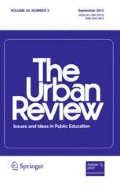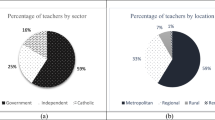Abstract
Centering the voices of Teachers of Color creates an opportunity to understand frequently overlooked ways in which they navigate racial hierarchies in their quest to teach and thrive in schools settings. This research study places aspiring and current Teachers of Color at the center by examining their teaching and learning experiences through the analysis of their written testimonies to identify common academic and professional interests and explore how they navigate challenges to these interests.
Similar content being viewed by others
References
Almen, E., & Almen, S. M. (2010). “Do Latina interests always have to ‘converge’ with White interests?” (Re)claiming racial realism and interest convergence in critical race theory praxis. Race, Ethnicity, and Education, 13(1), 1–21.
Bell, D. A. (1980). Brown v. Board of Education and the interest-convergence dilemma. Harvard Law Review, 93(518), 518–533.
Brown, A. L. (2012a). On human kinds and role models: A critical discussion about the African American male teacher. Educational Studies, 48, 296–315.
Brown, B. (2012b). Daring greatly: How the courage to be vulnerable transforms the way we live, love, parent, and lead. New York: Avery.
Brown, K. D. (2014). Teaching in color: A critical race theory in education analysis of the literature on preservice Teachers of Color and teacher education in the US. Race Ethnicity and Education, 17(3), 326–345.
Clark, L. M., Frank, T. L., & Davis, J. (2013). Conceptualizing the African American mathematics teacher as a key figure in the African American education historical narrative. Teachers College Record, 115, 1–29.
Collins, P. H. (2013). On intellectual activism. Philadelphia, PA: Temple University Press.
Crenshaw, K., Gotanda, N., Peller, G., & Thomas, K. (1995). Critical race theory: The key writings that formed the movement. New York, NY: The New Press.
Dee, T. (2004). Teachers, race, and student achievement in a randomized experiment. The Review of Economics and Statistics, 86(1), 195–210.
Delgado, R. (2000). Storytelling for oppositionists and others: A plea for narrative. In R. Delgado & J. Stefancic (Eds.), Critical race theory: The cutting edge (pp. 60–70). Philadelphia, PA: Temple University Press.
Delgado Bernal, D., Burciaga, R., & Flores Carmona, J. (2012). Chicana/Latina testimonios: Mapping the methodological, pedagogical, and political. Equity & Excellence in Education, 45(3), 363–372.
Delgado, R., & Stefancic, J. (2001). Critical race theory: An introduction. New York, NY: NYU Press.
Eddy, C. M., & Easton-Brooks, D. (2011). Ethnic matching, school placement, and mathematics achievement of African American students from kindergarten through fifth grade. Urban Education, 46(6), 1280–1299.
Egalite, A. J., Kisida, B., & Winters, M. A. (2015). Representation in the classroom: The effect of own-race teachers on student achievement. Economics of Education Review, 45, 44–45.
Gist, C. D. (2014). Interrogating critical pedagogy: Teachers of Color and the unfinished project of justice. In P. Orelus & R. Brock (Eds.), Interrogating critical pedagogy: The voices of educators of color in the movement (pp. 46–59). New York: Routledge.
Gist, C. D. (2017a). Culturally responsive pedagogy for teachers of color. The New Educator, 13(3), 288–303.
Gist, C. D. (Ed.). (2017b). Portraits of anti-racist alternative routes to teaching in the U.S.: Framing teacher development for community, justice, and visionaries. New York: Peter Lang.
Gist, C. D. (2017c). Voices of teachers of color: Unraveling the double bind in teacher education. Urban Education, 52(8), 927–956.
Grissom, J. A., & Redding, C. (2016). Discretion and disproportionality: Explaining the underrepresentation of high-achieving students of color in gifted programs. AERA Open, 2(1), 1–25.
Harris, C. I. (1993). Whiteness as property. Harvard Law Review, 106(8), 1707–1791.
Harris-Perry, M. V. (2011). Sister citizen: Shame, stereotypes, and Black women in America. New Haven, CT: Yale University Press.
Hussar, W. J., & Bailey, T. M. (2014). Projections of education statistics to 2022. (NCES 2014-051). U.S. Department of Education, National Center for Education Statistics. Washington, DC: U.S. Government Printing Office.
Ingersoll, R., & Merrill, L. (2017). A quarter century of changes in the elementary and secondary teaching force: From 1987 to 2012. Statistical analysis report (NCES 2017-092). U.S. Department of Education. Washington, DC: National Center for Education Statistics. Retrieved from: http://files.eric.ed.gov/fulltext/ED573526.pdf.
Irvine, J. (2003). Educating teachers for diversity: Seeing with a cultural eye. New York: Teachers College Press.
Kelly, H. (2012). “Just something gone, but nothing missing”: Booker T. Washington, Nannie Helen Burroughs, and the social significance of black teachers theorizing across two centuries. Educational Studies, 48, 215–219.
Knaus, C. B. (2009). Shut up and listen: Applied critical race theory in the classroom. Race Ethnicity and Education, 12(2), 133–154.
Ladson-Billings, G. (2013). Critical race theory—What it is not! In M. Lynn & A. D. Dixson (Eds.), Handbook of critical race theory in education (pp. 34–47). New York: Routledge.
Ladson-Billings, G., & Tate, W. F. (1995). Toward a critical race theory of education. Teachers College Record, 97(1), 47–68.
Lynn, M., & Dixson, A. D. (Eds.). (2013). Handbook of critical race theory in education. New York: Routledge.
Melvin, H., & The Blue Notes. (1975). Wake up everybody. On Wake up everybody [record]. Philadelphia: Philadelphia International Records.
Milner, H. R., IV. (2008). Critical race theory and interest convergence as analytic tools in teacher education policies and practices. Journal of Teacher Education, 59(4), 332–346.
Milner, H. R., Pearman, F. A., & McGee, E. O. (2013). Critical race theory, interest convergence, and teacher education. In M. Lynn & A. D. Dixson (Eds.), Handbook of critical race theory in education (pp. 339–354). New York: Routledge.
Orelus, P., & Brock, R. (2014). Interrogating critical pedagogy: The voices of educators of color in the movement. New York, NY: Routledge.
Philip, T. M. (2013). Experience as college student activists: A strength and liability for prospective Teachers of Color in urban schools. Urban Education, 48(1), 44–68.
Robinson, S. (2016). Welcoming remarks. Retrieved March 9, 2016. https://secure.aacte.org/apps/rl/res_get.php?fid=2459&ref=rl.
Sleeter, C. E. (2017). Critical race theory and the whiteness of teacher education. Urban Education, 52(2), 155–169.
Sleeter, C., Neal, L. I., & Kumashiro, K. K. (2014). Diversifying the teacher workforce: Preparing and retaining highly effective teachers. New York: Routledge.
Solorzano, D. (1997). Images and words that wound: Critical race theory, racial stereotyping and teacher education. Teacher Education Quarterly, 24(3), 5–19.
Solorzano, D. G., & Yosso, T. J. (2002). Critical race methodology: Counter-storytelling as an analytical framework for education research. Qualitative Inquiry, 8(1), 23–44.
Stovall, D. (2013). Fightin’ the devil 24/7”: Context, community, and critical race praxis in education. In M. Lynn & A. D. Dixson (Eds.), Handbook of critical race theory in education (pp. 289–301). New York, NY: Routledge.
The Santa Cruz Feminist of Color Collective. (2014). Building on “the edge” of each other’s battles: A feminist of color multidimensional lens. Hypatia, 29(1), 23–40.
U.S. Department of Education, Office of Planning, Evaluation and Policy Development, Policy and Program Studies Service. (2016). The state of racial diversity in the educator workforce, Washington, D.C. Retrieved from: https://www2.ed.gov/rschstat/eval/highered/racial-diversity/state-racial-diversity-workforce.pdf.
Villegas, A. M., & Davis, D. (2008). Preparing Teachers of Color to confront racial/ethnic disparities in educational outcomes. In M. Cochran-Smith, S. Feiman-Nemser, & D. J. McIntyre (Eds.), Handbook of research in teacher education: Enduring questions in changing contexts (pp. 583–605). New York, NY: Routledge.
Villegas, A. M., & Irvine, J. J. (2010). Diversifying the teaching force: An examination of major arguments. Urban Review, 42(3), 175–192.
Villegas, A. M., Strom, K., & Lucas, T. (2012). Closing the racial/ethnic gap between students of color and their teachers: An elusive goal. Equity and Excellence in Education, 45(2), 283–301.
Yamamoto, E. K. (1999). Interracial justice: Conflict and reconciliation in post-civil rights America. New York: NYU Press.
Yosso, T. J. (2005). Whose culture has capital? A critical race theory discussion of cultural wealth. Race Ethnicity and Education, 8(1), 69–91.
Author information
Authors and Affiliations
Corresponding author
Rights and permissions
About this article
Cite this article
Gist, C.D. Moving Teachers of Color from the Margin to the Center: Analyzing Teacher Testimonies of Educational Aspiration. Urban Rev 50, 517–538 (2018). https://doi.org/10.1007/s11256-018-0454-0
Published:
Issue Date:
DOI: https://doi.org/10.1007/s11256-018-0454-0




